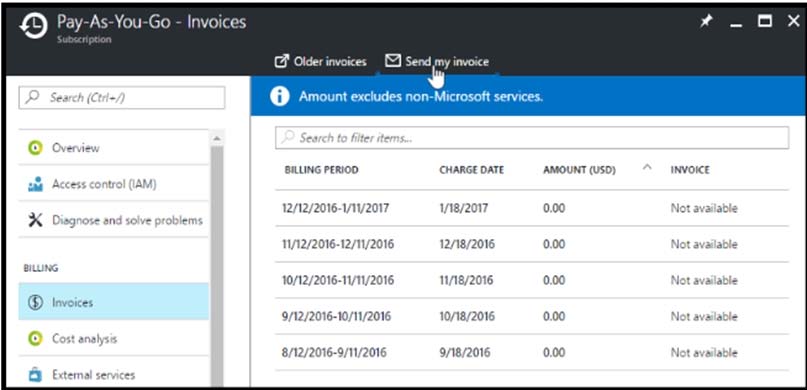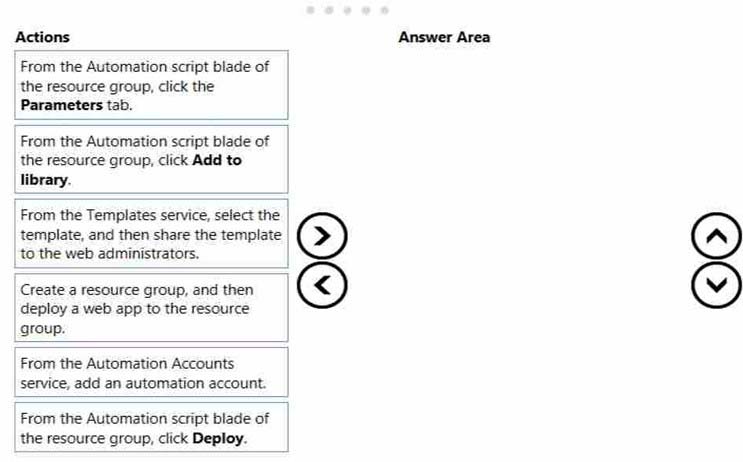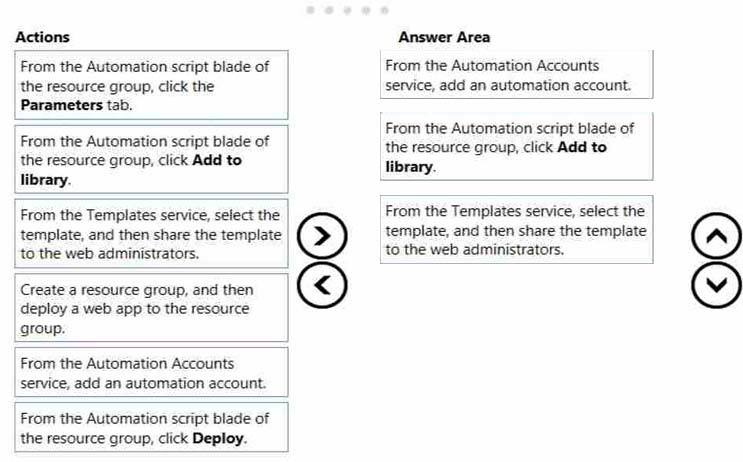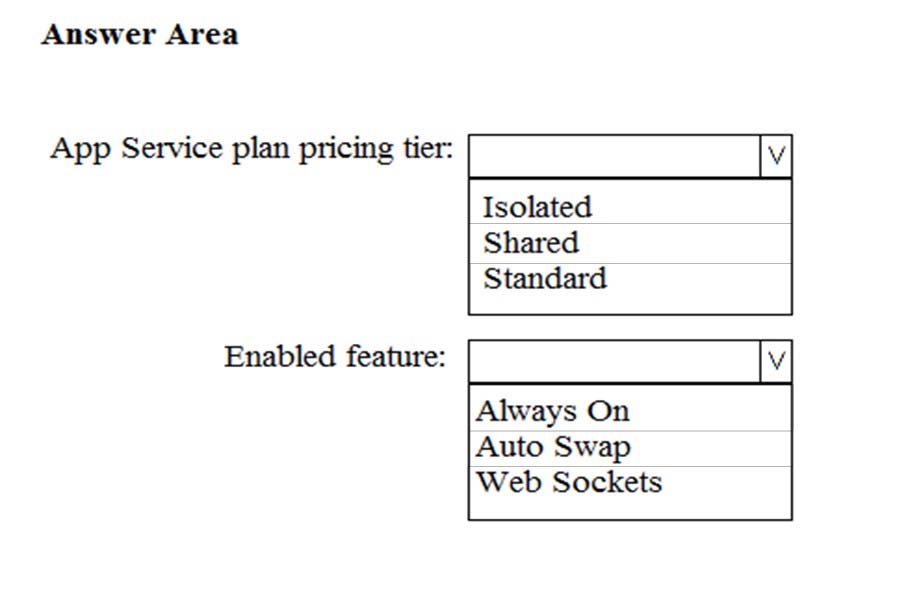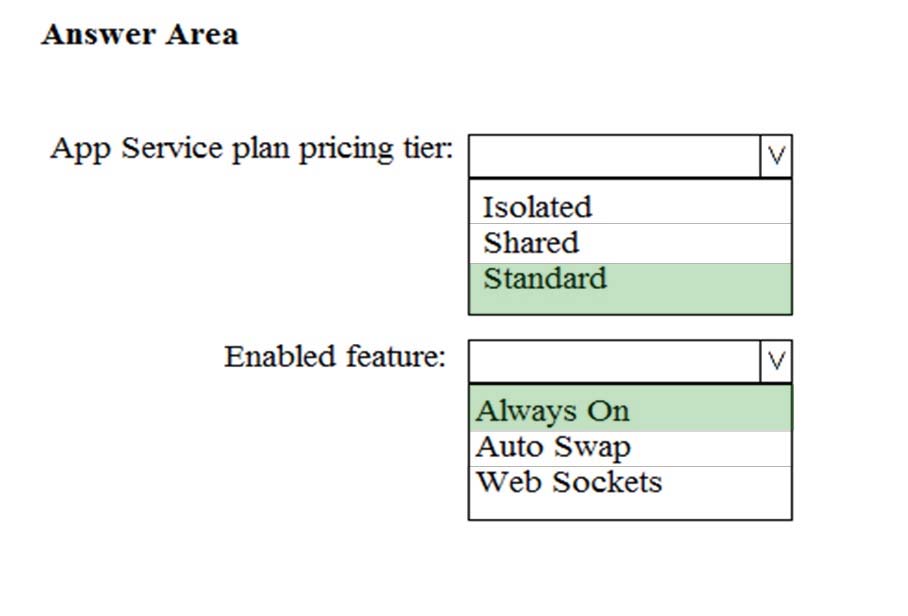AZ-300 Practice Test Free – 50 Questions to Test Your Knowledge
Are you preparing for the AZ-300 certification exam? If so, taking a AZ-300 practice test free is one of the best ways to assess your knowledge and improve your chances of passing. In this post, we provide 50 free AZ-300 practice questions designed to help you test your skills and identify areas for improvement.
By taking a free AZ-300 practice test, you can:
- Familiarize yourself with the exam format and question types
- Identify your strengths and weaknesses
- Gain confidence before the actual exam
50 Free AZ-300 Practice Questions
Below, you will find 50 free AZ-300 practice questions to help you prepare for the exam. These questions are designed to reflect the real exam structure and difficulty level.
You have a resource group named RG1 that contains the following: ✑ A virtual network that contains two subnets named Subnet1 and Subnet2 ✑ An Azure Storage account named contososa1 ✑ An Azure firewall deployed to Subnet2 You need to ensure that contososa1 is accessible from Subnet1 over the Azure backbone network. What should you do?
A. Deploy an Azure firewall to Subnet1.
B. Remove the Azure firewall.
C. Implement a virtual network service endpoint.
D. Create a stored access policy for contososa1.
Note: This question is part of series of questions that present the same scenario. Each question in the series contains a unique solution that might meet the stated goals. Some question sets might have more than one correct solution, while others might not have a correct solution. After you answer a question in this section, you will NOT be able to return to it. As a result, these questions will not appear in the review screen. You have an Azure Active Directory (Azure AD) tenant named contoso.com. A user named Admin1 attempts to create an access review from the Azure Active Directory admin center and discovers that the Access reviews settings are unavailable. Admin1 discovers that all the other Identity Governance settings are available. Admin1 is assigned the User administrator, Compliance administrator, and Security administrator roles. You need to ensure that the Admin1 can create access reviews in contoso.com. Solution: You assign the Global administrator role to Admin1. Does this meet the goal?
A. Yes
B. No
Note: This question is part of series of questions that present the same scenario. Each question in the series contains a unique solution that might meet the stated goals. Some question sets might have more than one correct solution, while others might not have a correct solution. After you answer a question in this section, you will NOT be able to return to it. As a result, these questions will not appear in the review screen. You have an Azure Active Directory (Azure AD) tenant named contoso.com. A user named Admin1 attempts to create an access review from the Azure Active Directory admin center and discovers that the Access reviews settings are unavailable. Admin1 discovers that all the other Identity Governance settings are available. Admin1 is assigned the User administrator, Compliance administrator, and Security administrator roles. You need to ensure that the Admin1 can create access reviews in contoso.com. Solution: You consent to Azure AD Privileged Identity Management (PIM). Does this meet the goal?
A. Yes
B. No
A company plans to use third-party application software to perform complex data analysis processes. The software will use up to 500 identical virtual machines (VMs) based on an Azure Marketplace VM image. You need to design the infrastructure for the third-party application server. The solution must meet the following requirements: ✑ The number of VMs that are running at any given point in time must change when the user workload changes. ✑ When a new version of the application is available in Azure Marketplace it must be deployed without causing application downtime. ✑ Use VM scale sets. ✑ Minimize the need for ongoing maintenance. Which two technologies should you recommend? Each correct answer presents part of the solution. NOTE: Each correct selection is worth one point.
A. single storage account
B. autoscale
C. single placement group
D. managed disks
You create an Azure virtual machine named VM1 in a resource group named RG1. You discover that VM1 performs slower than expected. You need to capture a network trace on VM1. What should you do?
A. From Diagnostic settings for VM1, configure the performance counters to include network counters.
B. From the VM1 blade, configure Connection troubleshoot.
C. From the VM1 blade, install performance diagnostics and run advanced performance analysis
D. From Diagnostic settings for VM1, configure the log level of the diagnostic agent.
Note: This question is part of series of questions that present the same scenario. Each question in the series contains a unique solution that might meet the stated goals. Some question sets might have more than one correct solution, while others might not have a correct solution. After you answer a question in this section, you will NOT be able to return to it. As a result, these questions will not appear in the review screen. You have an Azure subscription. You have an on-premises file server named Server1 that runs Windows Server 2019. You manage Server1 by using Windows Admin Center. You need to ensure that if Server1 fails, you can recover the data from Azure. Solution: You create an Azure Storage account and an Azure Storage Sync service. You configure Azure File Sync for Server1. Does this meet the goal?
A. Yes
B. No
Note: This question is part of series of questions that present the same scenario. Each question in the series contains a unique solution that might meet the stated goals. Some question sets might have more than one correct solution, while others might not have a correct solution. After you answer a question in this section, you will NOT be able to return to it. As a result, these questions will not appear in the review screen. You have a server named Server1 that runs Windows Server 2019. Server1 is a container host. You are creating a Dockerfile to build a container image. You need to add a file named File1.txt from Server1 to a folder named C:Folder1 in the container image. Solution: You add the following line to the Dockerfile. XCOPY File1.txt C:Folder1 You then build the container image. Does this meet the goal?
A. Yes
B. No
A company is migrating an existing on-premises third-party website to Azure. The website is stateless. The company does not have access to the source code for the website. They have the original installer. The number of visitors at the website varies throughout the year. The on-premises infrastructure was resized to accommodate peaks but the extra capacity was not used. You need to implement a virtual machine scale set instance. What should you do -
A. Use a webhook to log autoscale failures.
B. Use an autoscale setting to scale instances vertically.
C. Use only default diagnostics metrics to trigger autoscaling
D. Use an autoscale setting to define more profiles that have one or more autoscale rules.
Note: This question is part of series of questions that present the same scenario. Each question in the series contains a unique solution that might meet the stated goals. Some question sets might have more than one correct solution, while others might not have a correct solution. After you answer a question in this section, you will NOT be able to return to it. As a result, these questions will not appear in the review screen. You have a server named Server1 that runs Windows Server 2019. Server1 is a container host. You are creating a Dockerfile to build a container image. You need to add a file named File1.txt from Server1 to a folder named C:Folder1 in the container image. Solution: You add the following line to the Dockerfile. COPY File1.txt C:/Folder1/ You then build the container image. Does this meet the goal?
A. Yes
B. No
Note: This question is part of series of questions that present the same scenario. Each question in the series contains a unique solution that might meet the stated goals. Some question sets might have more than one correct solution, while others might not have a correct solution. After you answer a question in this section, you will NOT be able to return to it. As a result, these questions will not appear in the review screen. You have an Azure Active Directory (Azure AD) tenant named contoso.com. A user named Admin1 attempts to create an access review from the Azure Active Directory admin center and discovers that the Access reviews settings are unavailable. Admin1 discovers that all the other Identity Governance settings are available. Admin1 is assigned the User administrator, Compliance administrator, and Security administrator roles. You need to ensure that the Admin1 can create access reviews in contoso.com. Solution: You purchase an Azure Directory Premium P2 license for contoso.com. Does this meet the goal?
A. Yes
B. No
Note: This question is part of series of questions that present the same scenario. Each question in the series contains a unique solution that might meet the stated goals. Some question sets might have more than one correct solution, while others might not have a correct solution. After you answer a question in this section, you will NOT be able to return to it. As a result, these questions will not appear in the review screen. You have a server named Server1 that runs Windows Server 2019. Server1 is a container host. You are creating a Dockerfile to build a container image. You need to add a file named File1.txt from Server1 to a folder named C:Folder1 in the container image. Solution: You add the following line to the Dockerfile. COPY File1.txt /Folder1/ You then build the container image. Does this meet the goal?
A. Yes
B. No
Note: This question is part of series of questions that present the same scenario. Each question in the series contains a unique solution that might meet the stated goals. Some question sets might have more than one correct solution, while others might not have a correct solution. After you answer a question in this section, you will NOT be able to return to it. As a result, these questions will not appear in the review screen. You have an Azure subscription. You have an on-premises file server named Server1 that runs Windows Server 2019. You manage Server1 by using Windows Admin Center. You need to ensure that if Server1 fails, you can recover the data from Azure. Solution: From the Azure portal, you create a Recovery Services vault. On VM1, you install the Azure Backup agent and you schedule a backup. Does this meet the goal?
A. Yes
B. No
Note: This question is part of series of questions that present the same scenario. Each question in the series contains a unique solution that might meet the stated goals. Some question sets might have more than one correct solution, while others might not have a correct solution. After you answer a question in this section, you will NOT be able to return to it. As a result, these questions will not appear in the review screen. You have a server named Server1 that runs Windows Server 2019. Server1 is a container host. You are creating a Dockerfile to build a container image. You need to add a file named File1.txt from Server1 to a folder named C:Folder1 in the container image. Solution: You add the following line to the Dockerfile. Copy-Item File1.txt C:Folder1File1.txt You then build the container image. Does this meet the goal?
A. Yes
B. No
Your company has an Azure subscription. You enable multi-factor authentication (MFA) for all users. The company's help desk reports an increase in calls from users who receive MFA requests while they work from the company's main office. You need to prevent the users from receiving MFA requests when they sign in from the main office. What should you do?
A. From Azure Active Directory (Azure AD), configure organizational relationships.
B. From the MFA service settings, create a trusted IP range.
C. From Conditional access in Azure Active Directory (Azure AD), create a custom control.
D. From Conditional access in Azure Active Directory (Azure AD), create a named location.
You create a container image named Image1 on a developer workstation. You plan to create an Azure Web App for Containers named WebAppContainer that will use Image1. You need to upload Image1 to Azure. The solution must ensure that WebAppContainer can use Image1. To which storage type should you upload Image1?
A. Azure Container Registry
B. an Azure Storage account that contains a blob container
C. an Azure Storage account that contains a file share
D. Azure Container Instances
You have a server named Server1 that runs Windows Server 2019. Server1 is a container host. You plan to create a container image. You create the following instructions in a text editor. FROM mcr.microsoft.com/windows/servercore:lts2019 LABEL maintainer=" User1@contoso.com " RUN dism.exe /online /enable-feature /all /featurename:iis-webserver /NoRestart RUN echo "Hello World!" > c:inetpubwwwrootindex.html You need to be able to automate the container image creation by using the instructions. To which file should you save the instructions?
A. dockerconfig.json
B. Dockerfile
C. daemon.json
D. Build.ini
You monitor Azure virtual machines by using Azure Monitor. You plan to restart the virtual machines when CPU usage exceeds 95 percent for more than 30 minutes. You need to create an alert in Azure Monitor to restart the virtual machines. The solution must minimize administrative effort. Which type of action should you use in the alert?
A. ITSM
B. Webhook
C. Automation Runbook
D. Logic App
You have an Azure web app named App1 that is configured to run between two and five instances. There are currently three instances of App1 running. App1 has the following autoscale rules: ✑ Increase the instance count by one when the CPU percentage is greater or equal to 80. ✑ Decrease the instance count by one when the CPU percentage is less than or equal to 60. You are evaluating the following CPU percentage of utilization for App1: ✑ 60% ✑ 55% ✑ 50% ✑ 45% You need to identify which utilizations will cause App1 to scale in.
A. 45% only
B. 45% and 50% only
C. 50% and 55% only
D. 45%, 50%, and 55% only
You have an Azure subscription named Subscription1 that contains an Azure virtual network named VNet1. VNet1 connects to your on-premises network by using Azure ExpressRoute. You need to connect VNet1 to the on-premises network by using a site-to-site VPN. The solution must minimize cost. Which three actions should you perform? Each correct answer presents part of the solution. NOTE: Each correct selection is worth one point.
A. Create a VPN gateway that uses the VpnGw1 SKU.
B. Create a connection.
C. Create a local site VPN gateway.
D. Create a gateway subnet.
E. Create a VPN gateway that uses the Basic SKU.
A company is migrating an existing on-premises third-party website to Azure. The website is stateless. The company does not have access to the source code for the website. They have the original installer. The number of visitors at the website varies throughout the year. The on-premises infrastructure was resized to accommodate peaks but the extra capacity was not used. You need to implement a virtual machine scale set instance. What should you do -
A. Use a webhook to log autoscale failures.
B. Use an autoscale setting to scale instances vertically.
C. Use only default diagnostics metrics to trigger autoscaling
D. Use an autoscale setting to define more profiles that have one or more autoscale rules.
Note: This question is part of series of questions that present the same scenario. Each question in the series contains a unique solution that might meet the stated goals. Some question sets might have more than one correct solution, while others might not have a correct solution. After you answer a question in this section, you will NOT be able to return to it. As a result, these questions will not appear in the review screen. You have an Azure subscription. You have an on-premises file server named Server1 that runs Windows Server 2019. You manage Server1 by using Windows Admin Center. You need to ensure that if Server1 fails, you can recover the data from Azure. Solution: You create a Recovery Services vault and configure a backup by using Windows Server Backup. Does this meet the goal?
A. Yes
B. No
You need to move the blueprint files to Azure. What should you do?
A. Use the Azure Import/Export service.
B. Use Azure Storage Explorer to copy the files.
C. Generate a shared access signature (SAS). Map a drive, and then copy the files by using File Explorer.
D. Generate an access key. Map a drive, and then copy the files by using File Explorer.
Which pricing tier should you recommend for WebApp1?
A. D1
B. P1v2
C. S1
D. B1
You need to recommend an identity solution that meets the technical requirements. What should you recommend?
A. cloud-only user accounts
B. password hash synchronization and single sign-on (SSO)
C. Pass-through Authentication and single sign-on (SSO)
D. federated single sign-on (SSO) and Active Directory Federation Services (AD FS)
You need to meet the technical requirement for VM4. What should you create and configure?
A. an Azure Logic App
B. an Azure Service Bus
C. an Azure Notification Hub
D. an Azure Event Hub
You need to implement a backup solution for App1 after the application is moved. What should you create first?
A. an Azure Backup Server
B. a Recovery Services vault
C. a backup policy
D. a recovery plan
You need to configure a host name for WebApp2. What should you do first?
A. In Azure AD, add contoso.com as a custom domain name
B. In the public DNS zone of contoso.onmicrosoft.com, add an NS record
C. In Azure AD, add webapp2.azurewebsites.net as a custom domain name
D. In the public DNS zone of contoso.com, add a CNAME record
You have an Azure SQL database named Db1 that runs on an Azure SQL server named SQLserver1. You need to ensure that you can use the query editor on the Azure portal to query Db1. What should you do?
A. Modify the Advanced Data Security settings of Db1
B. Configure the Firewalls and virtual networks settings for SQLserver1
C. Copy the ADO.NET connection string of Db1 and paste the string to the query editor
D. Approve private endpoint connections for SQLserver1
Which blade should you instruct the finance department auditors to use?
A. Partner information
B. Cost analysis
C. Resource providers
D. Invoices
Note: This question is part of series of questions that present the same scenario. Each question in the series contains a unique solution that might meet the stated goals. Some question sets might have more than one correct solution, while others might not have a correct solution. After you answer a question in this section, you will NOT be able to return to it. As a result, these questions will not appear in the review screen. You have a server named Server1 that runs Windows Server 2019. Server1 is a container host. You are creating a Dockerfile to build a container image. You need to add a file named File1.txt from Server1 to a folder named C:Folder1 in the container image. Solution: You add the following line to the Dockerfile. ADD File1.txt C:/Folder1/ You then build the container image. Does this meet the goal?
A. Yes
B. No
You need to prepare the environment to meet the authentication requirements. Which two actions should you perform? Each correct answer presents part of the solution NOTE: Each correct selection is worth one point.
A. Allow inbound TCP port 8080 to the domain controllers in the Miami office
B. Install Azure AD Connect on a server in the Miami office and enable Pass-through Authentication
C. Install the Active Directory Federation Services (AD FS) role on a domain controller in the Miami office
D. Join the client computers in the Miami office to Azure AD
E. Add http://autologon.microsoftazuread-sso.com to the intranet zone of each client computer in the Miami office.
HOTSPOT - You need to implement Role1. Which command should you run before you create Role1? To answer, select the appropriate options in the answer area. NOTE: Each correct selection is worth one point. Hot Area:
You discover that VM3 does NOT meet the technical requirements. You need to verify whether the issue relates to the NSGs. What should you use?
A. Diagram in VNet1
B. Diagnostic settings in Azure Monitor
C. IP flow verify in Azure Network Watcher
D. Diagnose and solve problems in Traffic Manager profiles
E. the security recommendations in Azure Advisor
HOTSPOT - You need to prepare the environment to implement the planned changes for Server2. What should you do? To answer, select the appropriate options in the answer area. NOTE: Each correct selection is worth one point. Hot Area:
You need to recommend a solution to automate the configuration for the finance department users. The solution must meet the technical requirements. What should you include in the recommendation?
A. an Azure logic app and the Microsoft Identity Management (MIM) client
B. Azure AD Identity Protection
C. dynamic groups and conditional access policies
D. Azure AD B2C
You have an Azure Cosmos DB account named Account1. Account1 includes a database named DB1 that contains a container named Container1. The partition key for Container1 is set to /city. You plan to change the partition key for Container1. What should you do first?
A. Regenerate the keys for Account1.
B. Create a new container in DB1.
C. Delete Container1.
D. Implement the Azure Cosmos DB .NET SDK.
Note: This question is part of series of questions that present the same scenario. Each question in the series contains a unique solution that might meet the stated goals. Some question sets might have more than one correct solution, while others might not have a correct solution. After you answer a question in this section, you will NOT be able to return to it. As a result, these questions will not appear in the review screen. You have an Azure Active Directory (Azure AD) tenant that contains a group named Group1. You need to enable multi-factor authentication (MFA) for the users in Group1 only. Solution: From Multi-Factor Authentication, you select Bulk update, and you provide a CSV file that contains the members of Group1. Does this meet the goal?
A. Yes
B. No
Note: This question is part of series of questions that present the same scenario. Each question in the series contains a unique solution that might meet the stated goals. Some question sets might have more than one correct solution, while others might not have a correct solution. After you answer a question in this section, you will NOT be able to return to it. As a result, these questions will not appear in the review screen. You have an Azure Active Directory (Azure AD) tenant that contains a group named Group1. You need to enable multi-factor authentication (MFA) for the users in Group1 only. Solution: From the Azure portal, you configure an authentication method policy. Does this meet the goal?
A. Yes
B. No
You have an Azure Cosmos DB account named Account1. Account1 includes a database named DB1 that contains a container named Container1. The partition key for Container1 is set to /city. You plan to change the partition key for Container1. What should you do first?
A. Regenerate the keys for Account1.
B. Create a new container in DB1.
C. Delete Container1.
D. Implement the Azure Cosmos DB .NET SDK.
Note: This question is part of series of questions that present the same scenario. Each question in the series contains a unique solution that might meet the stated goals. Some question sets might have more than one correct solution, while others might not have a correct solution. After you answer a question in this section, you will NOT be able to return to it. As a result, these questions will not appear in the review screen. You have an Azure Active Directory (Azure AD) tenant that contains a group named Group1. You need to enable multi-factor authentication (MFA) for the users in Group1 only. Solution: From Multi-Factor Authentication, you select Bulk update, and you provide a CSV file that contains the members of Group1. Does this meet the goal?
A. Yes
B. No
Note: This question is part of series of questions that present the same scenario. Each question in the series contains a unique solution that might meet the stated goals. Some question sets might have more than one correct solution, while others might not have a correct solution. After you answer a question in this section, you will NOT be able to return to it. As a result, these questions will not appear in the review screen. You have an Azure Active Directory (Azure AD) tenant that contains a group named Group1. You need to enable multi-factor authentication (MFA) for the users in Group1 only. Solution: From the Azure portal, you configure an authentication method policy. Does this meet the goal?
A. Yes
B. No
DRAG DROP - You need to prepare the environment to ensure that the web administrators can deploy the web apps as quickly as possible. Which three actions should you perform in sequence? To answer, move the appropriate actions from the list of actions to the answer area and arrange them in the correct order. Select and Place:
HOTSPOT - You need to implement App2 to meet the application requirements. What should you include in the implementation? To answer, select the appropriate options in the answer area. NOTE: Each correct selection is worth one point. Hot Area:
You need to meet the security requirements. What should you use?
A. HTTP Strict Transport Security (HSTS)
B. Direct Line API
C. Multi-Factor Authentication (MFA)
D. Bot Framework Portal
E. Bot Framework authentication
HOTSPOT - You are evaluating the connectivity between the virtual machines after the planned implementation of the Azure networking infrastructure. For each of the following statements, select Yes if the statement is true. Otherwise, select No. Hot Area:
You need to implement the purchase requirement. What should you do?
A. Use the Bot Framework REST API conversation operations to send the user’s voice and the Speech Service API to recognize intents.
B. Use the Direct Line REST API to send the user’s voice and the Speech Service API to recognize intents.
C. Use the Speech Service API to send the user’s voice and the Bot Framework REST API conversation operations to recognize intents.
D. Use the Bot Framework REST API attachment operations to send the user’s voice and the Speech Service API to recognize intents.
You need to resolve the delivery API error. What should you do?
A. Implement simple retry by using the EnableRetryOnFailure feature of Entity Framework.
B. Implement exponential backoff by using the EnableRetryOnFailure feature of Entity Framework.
C. Implement a Circuit Breaker pattern by using the EnableRetryOnFailure feature of Entity Framework.
D. Invoke a custom execution strategy in Entity Framework.
You need to meet the vendor notification requirement. Solution: Create and apply a custom outbound Azure API Management policy. Does the solution meet the goal?
A. Yes
B. No
Note: This question is part of a series of questions that present the same scenario. Each question in the series contains a unique solution. Determine whether the solution meets the stated goals. You need to meet the vendor notification requirement. Solution: Configure notifications in the Azure API Management instance. Does the solution meet the goal?
A. Yes
B. No
Note: This question is part of a series of questions that present the same scenario. Each question in the series contains a unique solution. Determine whether the solution meets the stated goals. You need to meet the vendor notification requirement. Solution: Update the Delivery API to send emails by using a cloud-based email service. Does the solution meet the goal?
A. Yes
B. No
Get More AZ-300 Practice Questions
If you’re looking for more AZ-300 practice test free questions, click here to access the full AZ-300 practice test.
We regularly update this page with new practice questions, so be sure to check back frequently.
Good luck with your AZ-300 certification journey!


